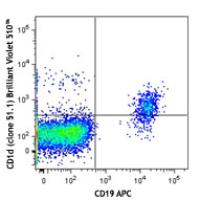-
Sign In
-

-
 Sony Biotechnology
Sony Biotechnology
-

-
 Sony Biotechnology
Sony Biotechnology
Brilliant Violet 510™ anti-human CD1d
Antibodies Single
Sony
51.1
Flow Cytometry
Mouse IgG2b, κ
Human
Human CD1d-Fc fusion
100 tests
2351570
$428.00
Description
CD1d is a MHC-like, type I transmembrane protein, member of the CD1 family and the immunoglobulin superfamily. On the cell surface, CD1d forms a heterodimer with β2-microglobulin. CD1d is expressed by antigen-presenting cells such as B cells, monocytes/macrophages, dendritic cells, and some non-lymphoid cells. Cortical thymocytes express CD1d but the expression is lost in mature T cells. CD1d presents lipid antigens to iNKT cells analogous to MHC molecule presentation of peptides to T cells.
Formulation
Phosphate-buffered solution, pH 7.2, containing 0.09% sodium azide and BSA (origin USA).Recommended Usage
Each lot of this antibody is quality control tested by immunofluorescent staining with flow cytometric analysis. For flow cytometric staining, the suggested use of this reagent is ≤5 microL per million cells or 5 microL per 100 microL of whole blood. It is recommended that the reagent be titrated for optimal performance for each application.
Brilliant Violet 510™ excites at 405 nm and emits at 510 nm. The bandpass filter 510/50 nm is recommended for detection, although filter optimization may be required depending on other fluorophores used. Be sure to verify that your cytometer configuration and software setup are appropriate for detecting this channel. Refer to your instrument manual or manufacturer for support. Brilliant Violet 510™ is a trademark of Sirigen Group Ltd.
This product is subject to proprietary rights of Sirigen Inc. and is made and sold under license from Sirigen Inc. The purchase of this product conveys to the buyer a non-transferable right to use the purchased product for research purposes only. This product may not be resold or incorporated in any manner into another product for resale. Any use for therapeutics or diagnostics is strictly prohibited. This product is covered by U.S. Patent(s), pending patent applications and foreign equivalents.
References
1. Exley M, et al. 2000. Immunology 100:37. (IHC, WB)
2. Durante-Mangoni E, et al. 2004. J. Immunol. 173:2159. (WB)
3. Yue SC, et al. 2005. P. Natl. Acad. Sci. USA 102:11811. (Stim)


